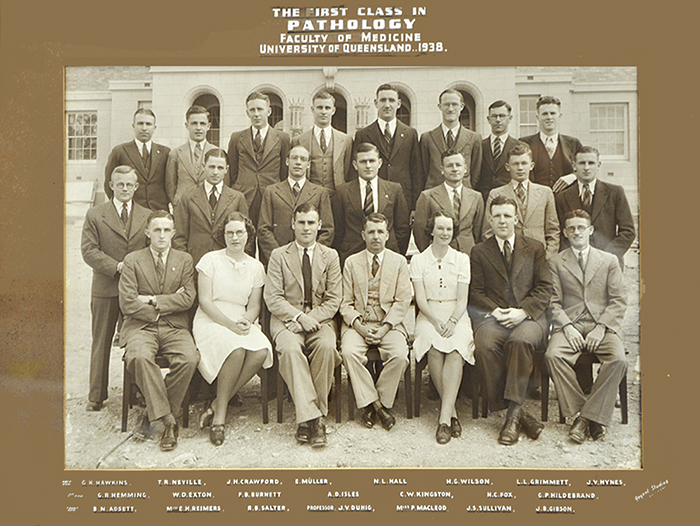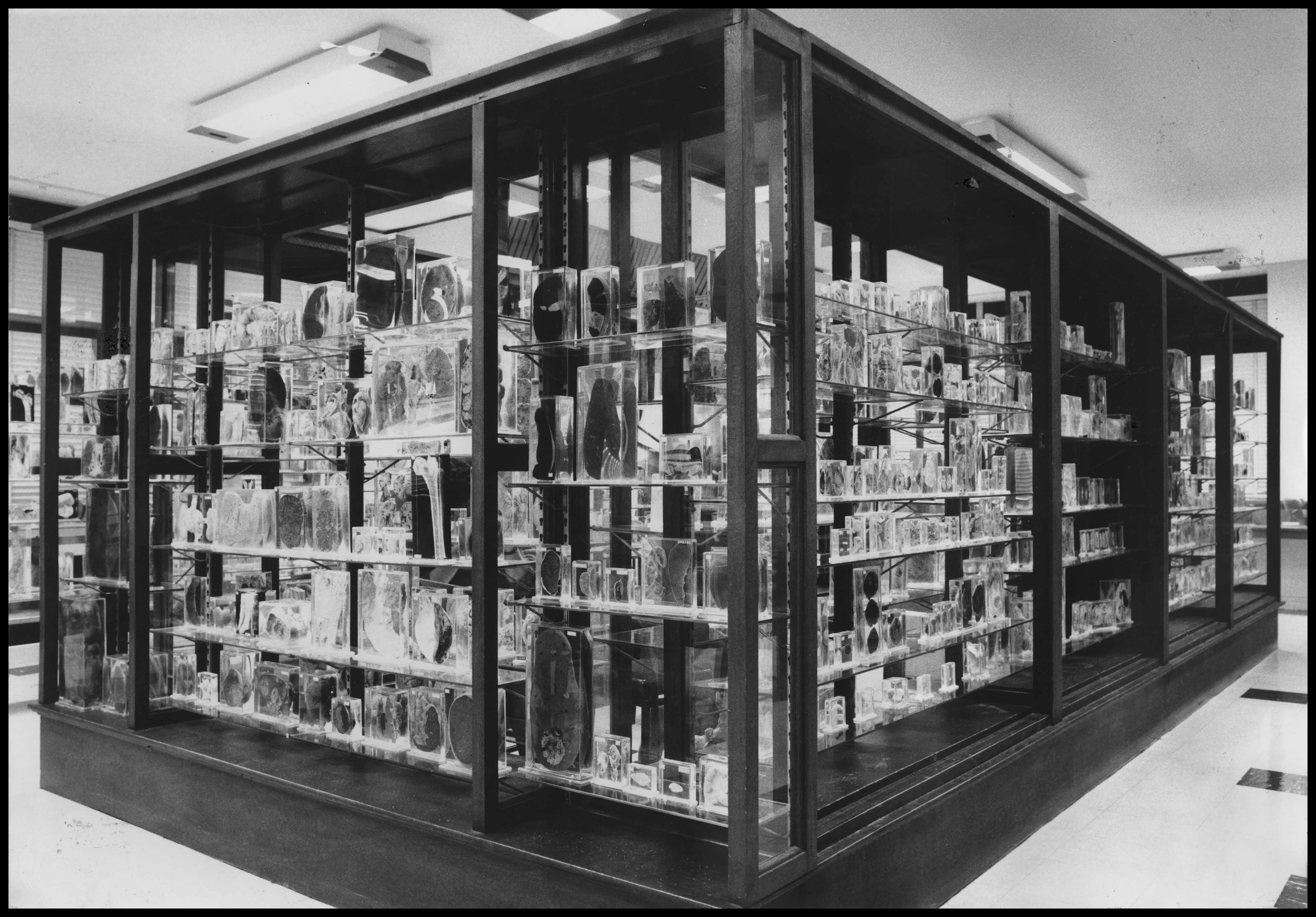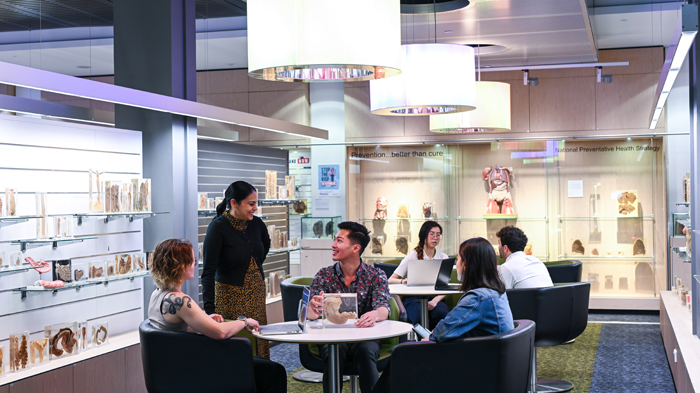Integrated Pathology Learning Centre

Mission Statement
The Integrated Pathology Learning Centre (IPLC) invites visitors to connect with stories of health, the human body, and lived experience to spark curiosity, creativity, and ethical scholarship. As stewards of an evolving collection, we foster learning that integrates human experience with critical inquiry and shared discovery.
Vision Statement
The Integrated Pathology Learning Centre (IPLC) envisions a future where learning from the human body will recognise attached cellular, emotional, and cultural memories and associated stories. We will build a compassionate community of care guided by respect, empathy, and integrity.
Click below to view more photographs of our museum:
Visiting the IPLC
- The IPLC is open to timetabled teaching activities or by appointment only. To make a booking, please follow the link: https://survey.app.uq.edu.au/Contact-the-IPLC.
- Photography/filming and food/drink (except water) are not permitted in the IPLC. Students are permitted to bring their personal devices, such as laptops and tablets, for study.
Location: The IPLC is located on Level 6 of the UQ Health Sciences Building (Cnr of Central Drive and Fig Tree Crescent) in the Herston/Royal Brisbane and Women's Hospital campus. We are directly opposite the UQ Centre for Clinical Research and Cafe Dose.
Secondary School Visits
The Integrated Pathology Learning Centre (IPLC) offers two secondary school programs that provide a rare opportunity for students to come face-to-face with a variety of diseases. During their visit, students will participate in workshops that cover a wide range of issues, exploring the pathology underlying health problems and disease prevention. This includes investigating the effects of behavioural and environmental factors on health and thinking critically about personal and peer attitudes to contemporary health issues.
Human Body & Disease
- Designed for students in Years 9 - 12
- Supports the Queensland Curriculum and Assessment Authority senior subject Biology and Health syllabuses and the Australian Curriculum Science syllabus
- Topics covered include brain stem injuries, diphtheria, smoking, polio, alcoholic cirrhosis, syphilis, genetic polycystic disease, heart attacks, and melanoma.
Psychology
- Designed for students in Years 11 - 12
- Supports the Queensland Curriculum and Assessment Authority senior subject Psychology syllabus and the International Baccalaureate Diploma Programme Psychology subject
- Topics covered include Alzheimer's disease, Parkinson's disease, brain stem injuries, the lobes of the brain and affiliated diseases/injuries, lobotomies, institutionalisation in Queensland and broader mental health issues such as addiction and stress.
Booking Forms
University Teaching
As well as supporting the Doctor of Medicine program, the IPLC engages with a diversity of undergraduate and postgraduate courses. The IPLC can enhance and support your teaching, whether through a formal course visit or an optional extracurricular tour or learning opportunity. For more information, please contact the Curator.
For some inspiration, we have asked a couple of our academic collaborators to summarise how they have integrated the IPLC into their teaching.
DEVB2000: Stem Cells, Development and Developmental Disorders
DEVB2000 explores the basic principles of how embryos develop the complex array of cells, tissues and organs that contribute to a healthy human. We further apply those principles to understanding how disturbances in developmental programs contribute to abnormalities and disorders in adulthood. Integrating a visit to the IPLC in our course has allowed our students to connect with the real-world consequences of aberrant developmental processes and to identify pathologies with developmental origins from real human specimens. The IPLC has an excellent collection that engages our students, enhances their learning, and motivates them to delve deeper into the course content. Student enthusiasm was evidenced by our end of the year student surveys, where many students indicated the IPLC site visit to be a highlight of their semester and an experience that reaffirmed their passion for medicine and developmental biology. Moreover, the IPLC is supported by excellent staff that make bringing our classes on site smooth and effortless.
- Dr David Simmons
HUMN3300: Masterclass - Advanced Research in the Humanities
Since 2022, a group of third-year Advanced Humanities students have completed an optional internship in the IPLC, as part of their program. This internship explores means of opening the museum to new audiences, and expanding teaching and learning techniques.
The students create interdisciplinary events in the museum space, bringing humanities and medical students into conversation, to draw on the productive differences in perspective between these cohorts in response to specific ethical questions. The themes of the events have changed from year to year, including topics such as ‘Ethical Autopsies’ and the ‘Spectacle of Death’.
The Advanced Humanities students create workstations surrounding specific pots or objects in the collection, and present a set of historical material and philosophical questions related to each piece. This material is used as a form of conversation starter, allowing mixed groups of medical and humanities students to move around the museum space, and converge in a full-group discussion about their insights at the end. Students from both cohorts have described these events as ‘incredibly eye-opening’ and something that brought ‘a whole new depth to my knowledge’.
- Dr Karin Sellberg
BIOM3015: Integrative Physiology and Pathophysiology
As part of the course Integrated Physiology and Pathophysiology (BIOM3015, 3rd year Biomedical Sciences course), students took part in a hands-on activity at the Integrated Pathology Learning Centre (IPLC), which they identified as a highlight of the course and thoroughly enjoyed. During their visit, they observed, sketched, and described three matched sets of organs—each including a healthy reference and a diseased specimen. This interactive experience allowed students to explore real anatomical changes associated with disease. Following the session, they selected one disease (different from their presentation topic) and completed a short assessment linking the observed anatomical changes to disease pathophysiology. This activity deepened their understanding of pathology and provided a memorable, engaging opportunity to apply their learning in a real-world context.
- Dr Melissa Reichelt
BIOM2015: Physiology and Pharmacology of Human Disease
As part of their learning about Physiology of Human Disease (BIOM2015), second-year health science students had the opportunity to engage with the museum specimens and explore the “anatomy of a disease” of their choosing. Across three sessions, students explored the museum to identify a candidate specimen reflecting their chosen disease or extra-manifestations of that disease, unpacked the physical disturbances apparent in the specimen to better understand how these contribute to dysregulated function, and staged a representative specimen to incorporate IPLC examples in a multimedia assignment. We also partnered with medical students who teach in the course and are familiar with the IPLC, to deliver a teacher’s guide complementing this learning by students at the museum. This culminated in a curated library of diseases, including a brief description of the disease, an image of an exemplary IPLC specimen, and description of the anatomical aberrations present. This enabled our teaching team to competently prompt students to reflect on what they know about the disease they’ve chosen, how they recognise the anatomical symptoms of the disease, and how they would pose their specimen to maximise visual representation of these disturbances for including in their multimedia production. This learning at the IPLC was greatly valued by students, particularly how it helped uplift their learning of course content and appreciate the diversity of disease anatomies.
- Dr Judit Kibedi
History
1900 - 1920
The foundation of a pathology museum in Queensland was first raised as early as 1900 at the scientific meetings of the Queensland Branch of the British Medical Association. In 1920, Dr James Vincent Duhig was appointed custodian of the collection.
1925
The oldest specimen in the collection was acquired in 1925. It is a segment of liver from a young female with tuberculosis. The accompanying archival records reveal how this disease developed at a time when no drug treatment was available.
1936 - 1947
The University of Queensland (UQ) established the School of Medicine in 1936. Dr Duhig was appointed Honorary Professor of Pathology (1937-1947) and transferred all specimens to the University. The first pathology class was held in 1938 for third year medical students. Dr Harry Wilson, a student in that cohort, recalled that the first practical pathology session, microscopic slide interpretation, was held in the nurses’ cooking room at the Brisbane General Hospital. Pathology teaching transferred to more appropriate accommodation at the Medical School at Herston when construction was completed in 1938.

1948 - 1963
The collection continued to grow under Professor A.J. Canny, the first full-time Professor of Pathology (1947 - 1963), Dr T.H. Vickers and Dr J.A. Inglis. Dr Vickers' work on the pathogenesis of thalidomide-induced defects was of world standard and many of his dissections remain in the collection today. In 1950, the collection was named the J.V. Duhig Museum of Pathology.
1974 - 1993
Professor John Kerr joined the UQ Pathology Department in 1965 and served as Professor of Pathology from 1974 until his retirement in 1995. While to the world John Kerr is known for his ground-breaking research on apoptosis, in Queensland he is also renowned for his contribution to medical education, having inspired a generation of medical students. He made enormous contributions to the Pathology Museum aiming to create a world class collection illustrating as many manifestations of the common diseases as possible. He was assisted by Museum Technical Curator Mr Alexander (Sandy) Powell, who prepared the specimens for display and provided specimens for the Professorial Departments of Medicine and Surgery.
1994 - 2001
By the early 1990s, active specimen collecting had declined as surgical and autopsy practices changed. Use of the collection was greatly reduced under Professor Jeremy Jass who served as Head of Pathology between 1996 and 2001. Digital resources and images were favoured and the museum space was reallocated for other purposes, a phenomenon which was occurring at other sites around the world.
2006
When the collection seemed in danger of becoming obsolete, enormous efforts were made by pathologists, educators, clinicians and the Royal College of Pathologists of Australasia to ensure its survival. In 2006, shortly after Professor Sunil Lakhani’s appointment as Head of the School of Medicine’s Discipline of Molecular and Cellular Pathology, a proposal to develop a centre of excellence for pathology education was put forward. The Integrated Pathology Learning Centre (IPLC) is the culmination of that effort.

2010 - Today
The IPLC opened in 2010 in the recently refurbished Health Sciences Building. It has fulfiled the vision of creating a 21st century facility where the latest technologies can be used alongside a world class specimen collection. With each year, the IPLC continues to grow, welcoming old and new audiences to be inspired by our collection.
Today, the collection includes just over 5 000 specimens. They are displayed alongside objects from UQ’s Marks-Hirschfeld Museum of Medical History and the RBWH Museum of Nursing History.
Donations
Pathology Specimens
The IPLC continues to accept donations to the collection. For more information, please contact the museum's curator.
All donated specimens are treated with utmost respect and are used for educational purposes only.
The video below highlights the story of a donor and her reasons for donation.
Contact us
Rebecca Lush
Curator
+61 7 3346 5130
r.lush@uq.edu.au
Paul Muffatti
Senior Curatorial Assistant and Conservator
+61 7 3346 5129
p.muffatti@uq.edu.au
Ally Beech
Conservation Assistant
alison.beech@uq.edu.au
